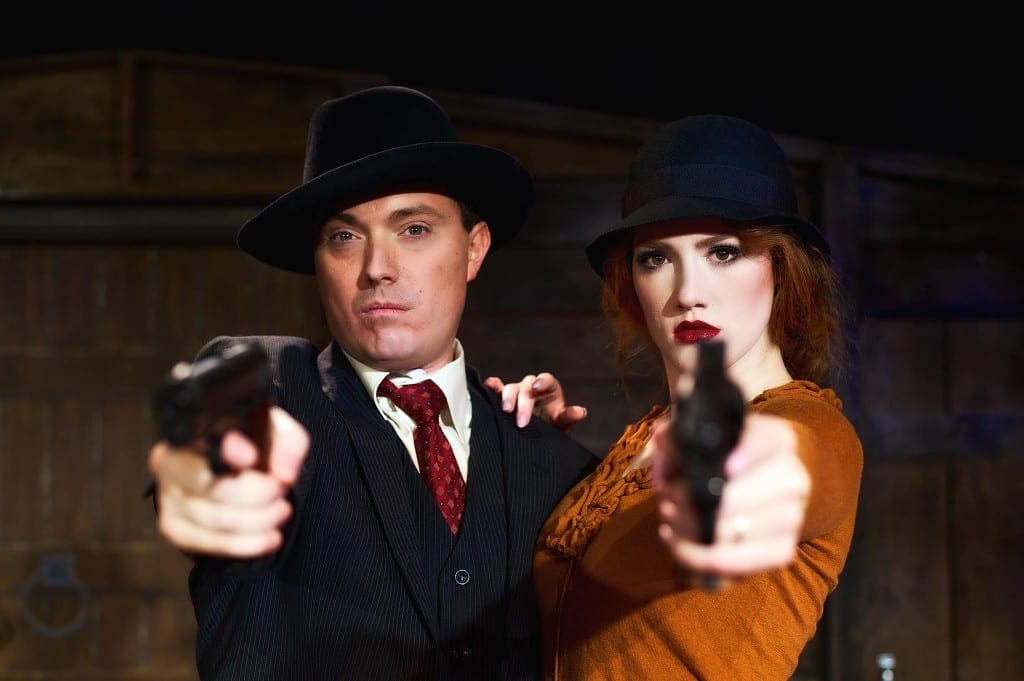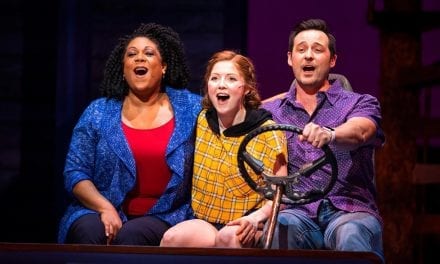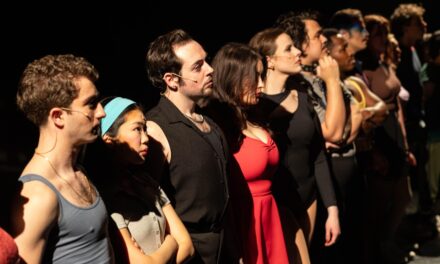LEHI — Utah Repertory Theatre Company is a relatively new company, with a focus on providing lesser known shows, regional premieres, and other theatrical experiences that are not available elsewhere in Utah. Such is the case with Bonnie and Clyde, a 2011 Broadway musical written by Frank Wildhorn (music), Don Black (lyrics), and Ivan Menchell (book).
The story follows the historical title characters, real life criminals during the Great Depression. Such subject matter may not seem like the recipe for a successful musical. However, the perennially popular story of Bonnie and Clyde and the magic of good writing and story telling made the show into a greater success than I would have expected. This particular production, while benefiting from an overall good story and music, went from entertaining to outstanding based on the absolutely wonderful choices made by the cast, crew, and theatre company. Trying to limit the elements that deserve praise in this show to a single review is a significant challenge.
The first noteworthy aspect of the show was evident as I arrived at the Lehi Arts Center. It is a small performance venue, and tucked in a corner of the stage sat a fully staffed orchestra pit. In an age where “canned” music is so often the option chosen by many theatrical endeavors—from community to professional—it was absolutely refreshing to see Utah Rep’s musicians, headed by Anjanette Mickelsen. What was even more pleasing wast the fact that the musicians were exceptional, and their music made the live experience of a play even more special. When I spoke with Mickelsen after the show, she stated that it is wonderful to work with a company who will pay their musicians, and that she is lucky to have such a wonderful team to work with.
The next element that struck me from the very beginning was the makeup, masterfully designed by hair and makeup designer Kelly Donahue. As the subject matter would dictate, Bonnie & Clyde has quite a bit of blood, bruising, and other aspects that in most theatrical venues can look fake. In the opening scene, two of the characters have blood on their faces, and while I was sitting on the front row, I still got almost scared that the blood was real. Throughout the show, characters were realistically bloodied and bruised, only to return a few scenes later without any traces left. Donahue must have been working tirelessly behind the scenes to create these visuals.
The costuming was also noteworthy. Nancy Susan Cannon deserves praised for her impressive detailed creation of the time period, from the hats, shoes, underclothing, gun holsters, and jewelry. I did not notice anything that seemed anachronistic. I was also impressed at how many of the costumes mirrored actually images of the original Bonnie and Clyde, especially one dress worn by Bonnie that I had seen in several history books.
Speaking of historical accuracy, this production had as part of their crew a dramaturg, which is someone who does research and development of a play. Curtis T. Cluff served as that role for this production, and his work proved to be phenomenal. One of the aspects of Utah Rep that I enjoy is that they offer a talkback once per run with the cast and crew. I was privileged to be in attendance at this chat session, and it was evident that Cluff had done his research both on the historical figures in the show, as well as the time period and history of the musical. This information proved to be valuable to the audience, as it was easily believed that we had been transported to the American midwest during the Depression.

Lisa Clayton as Cumie Barrow, Perry Whitehair as Henry Barrow, and Kimball Bradford as Young Clyde Barrow.
Finally, to discuss the performance of the cast, I could easily write several more pages. At the talkback it was apparent that each of the cast members had done their own research; they read memoirs, studied history books, watched old movies, and gathered any other information they could get their hands on. One way this was illustrated was with the two youngest members of the cast, Abigail Parkinson who played Young Bonnie, and Kimball Bradford, who played Young Clyde. Not only did these two have beautiful, strong voices, as shown in the opening number “Picture Show,” they also showed maturity in their acting understanding and ability. Parkinson mentioned in the chat that because she played a young Bonnie, studying the ending of Bonnie’s life was not nearly as important as studying one of the movie stars that the young Bonnie was known to love, so that Parkinson could imagine what it was like to have that person as her idol. These two portrayed their characters much better than most people do at their young age.
The ensemble number “God’s Arms are Always Open” featured excellent choreography from Ashley Ramsey, and a beautiful solo by the Preacher, played by Christopher Bradford. Each member of the ensemble and minor characters deserve praise for their portrayals, and Adam Cannon‘s direction throughout the show served to keep the pace active and lively, even with a somewhat dark story.
Finally, much also could be said about the four leading players. Buck, Clyde’s brother (played by Johnny Wilson) and Blanche (played by Twila Wilson) portrayed a realistic downtrodden couple struggling with the choice to be upstanding citizens or living the dangerous life of outlaws. Johnny Hebda played Clyde with a human dimension—especially in prison—that is often missing from the legend. Madeline Weinberger played Bonnie so that the character’s girlish innocence was never fully stomped out by the senseless violence all around her. All four of these actors have an immense amount of talent and various moments stood out. However some of the best work in the show was when they played off each other. When the Johnny Wilson and Hebda sang “When I Drive,” I saw a depth of character in both Buck and Clyde, which were enriched by the excellent harmonies. When the ladies sang the haunting ballad “You Love Who You Love,” I could see the raw emotion in both Twila Wilson and Weinberger’s faces and felt certain that the research they had done into their characters had paid off.
Overall, this was one of my favorite experiences with Utah theatre. I don’t remember when I have seen a company work so hard to understand and portray the characters the way they did. I was impressed with the fact that the creative team did all they could to discover learn about their show, going so far as to meeting with the composer himself, and working with one of the actors from the original Broadway run. This is what makes strong local theatre, and I hope to see more of it.








